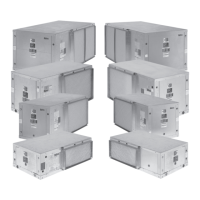NORMAL SEQUENCE OF OPERATION
The following sequence of operation is typical for ALP
SEASONCON air cooled condensing unit, models
ALP-045C
through ALP-230C [items in italics apply only to Models
ALP-12OC
thru ALP-230C). The sequence varies somewhat
depending upon options.
Startup
-
With the control circuit power on and the control
stop switch
S1
closed,
115V
power is applied through the con-
trol circuit fuse
F1
to the compressor crankcase heaters
HTR1,
HTR2
(HTR3,
HTR4),
the compressor motor protec-
tors
MP1,
MP2 (MP3, MP4) and the primary of the 24V con-
trol circuit transformer. The 24V transformer provides power
to the contacts of the low pressure controls
LP1
and LP2 and
the compressor lockout time delays
TD1
and TD2.
When the remote time clock or manual shutdown switch
turns on the chilled water pump, the flow switch closes and
115V
power is applied to the relay contacts on the unit ther-
mostat. The unit will automatically operate in response to the
unit thermostat provided the manual pumpdown switches
PS1
and PS2 are closed (in the “auto” position); the compressor
lockout time delays
TD1
and TD2 have closed, energizing
the safety relays
R5,
R6
(R7,
R8);
and the freezestats FS1
and FS2, high pressure controls HP1 and HP2, and com-
pressor motor protectors
MP1 ,
MP2 (MP3, MP4) do not sense
failure conditions.
On a call for cooling, the unit thermostat energizes the li-
quid line solenoid valve
SV1
for refrigerant circuit
#1.
This
opens the valve and allows refrigerant to flow through the
expansion valve and into the evaporator. As the evaporator
refrigerant pressure increases, the low pressure control
LP1
closes. This energizes the compressor starting relay
R9,
start-
ing the compressor via the compressor contactors Ml and
M5. Closing the
R9
contacts also energizes the condenser
fan motor contacts Ml
1,
M12, Ml3 and M14, starting the fan
motors.
As additional stages of cooling capacity are required, the
unit thermostat energizes the liquid line solenoid valve SV2
of the refrigerant circuit X2. After the compressor sequenc-
ing time delay
TD1
7
has closed, the same starting sequence
is initiated in refrigerant circuit
#2.
If still more cooling is required, the unit thermostat will start
the remaining compressors and then de-energize unloader
solenoids until the capacity requirement is met.
Pumpdown
-
As the unit thermostat is satisfied, it will
energize unloaders and unload the compressors, and then
de-energize the liquid line solenoid valves
SV1
and SV2,
causing the valves to close. When the compressor has
pumped most of the refrigerant out of the evaporator and in-
to the condenser, the low pressure controls LPI and LP2 will
open, shutting down the compressors and the condenser fan
motors. If refrigerant leaks into the evaporator, the increase
in pressure will cause the low pressure control
LP1
or LP2
to close. This will energize the compressor starting relays
R9
or R10 and start the compressor, which will quickly pump the
refrigerant out of the evaporator and into the condenser
(recycling pumpdown).
A compressor which repeats recycling
pumpdown
every
5 minutes indicates a malfunction due to the temperature con-
trol or a system cause. A build up of heat in the compressor
without proper cooling of suction gas could cause a
mechanical failure in the compressor.
McQuay
recommends
corrective measures be taken if the compressor recycles
repeatedly within
15-minute
intervals.
Page 22 / IM 269

